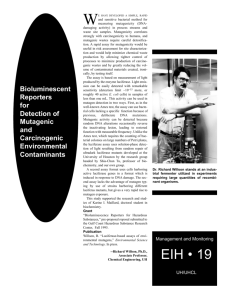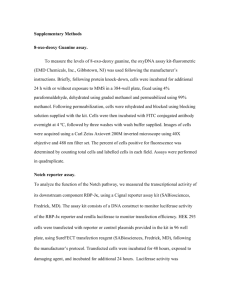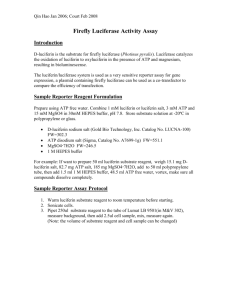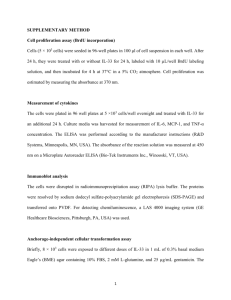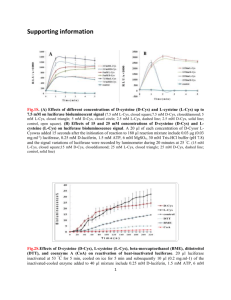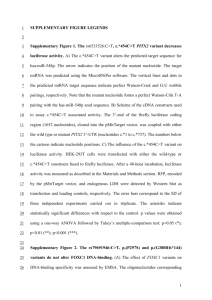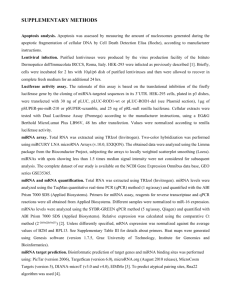Manual: Luciferase Assay Kit
advertisement
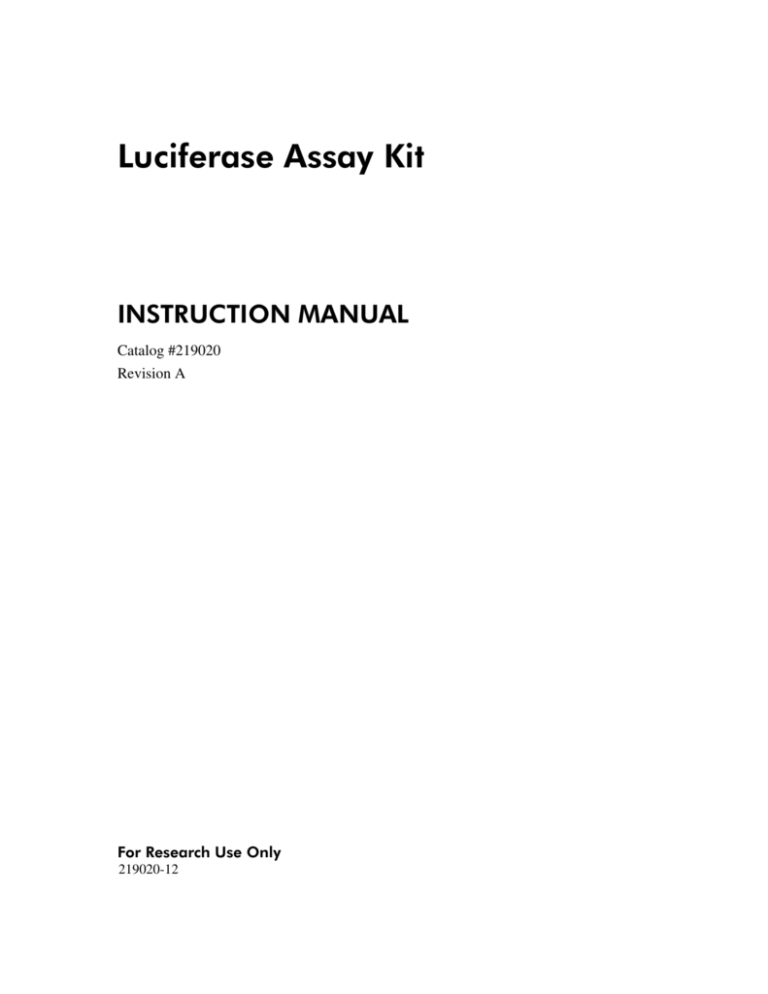
Luciferase Assay Kit INSTRUCTION MANUAL Catalog #219020 Revision A For Research Use Only 219020-12 LIMITED PRODUCT WARRANTY This warranty limits our liability to replacement of this product. No other warranties of any kind, express or implied, including without limitation, implied warranties of merchantability or fitness for a particular purpose, are provided by Agilent. Agilent shall have no liability for any direct, indirect, consequential, or incidental damages arising out of the use, the results of use, or the inability to use this product. ORDERING INFORMATION AND TECHNICAL SERVICES United States and Canada Agilent Technologies Stratagene Products Division 11011 North Torrey Pines Road La Jolla, CA 92037 Telephone (858) 373-6300 Order Toll Free (800) 424-5444 Technical Services (800) 894-1304 Internet techservices@agilent.com World Wide Web www.stratagene.com Europe Location Telephone Fax Technical Services Austria 0800 292 499 0800 292 496 0800 292 498 Belgium France Germany Netherlands Switzerland United Kingdom 00800 7000 7000 00800 7001 7001 00800 7400 7400 0800 15775 0800 15740 0800 15720 00800 7000 7000 00800 7001 7001 00800 7400 7400 0800 919 288 0800 919 287 0800 919 289 00800 7000 7000 00800 7001 7001 00800 7400 7400 0800 182 8232 0800 182 8231 0800 182 8234 00800 7000 7000 00800 7001 7001 00800 7400 7400 0800 023 0446 +31 (0)20 312 5700 0800 023 0448 00800 7000 7000 00800 7001 7001 00800 7400 7400 0800 563 080 0800 563 082 0800 563 081 00800 7000 7000 00800 7001 7001 00800 7400 7400 0800 917 3282 0800 917 3283 0800 917 3281 All Other Countries Please contact your local distributor. A complete list of distributors is available at www.stratagene.com. Luciferase Assay Kit Contents Materials Provided.............................................................................................................................. 1 Storage Conditions .............................................................................................................................. 1 Additional Materials Required .......................................................................................................... 1 Introduction......................................................................................................................................... 2 Extracting Luciferase from Tissue Culture Cells............................................................................. 3 Performing the Luciferase Activity Assay ........................................................................................ 4 Active Lysis Protocol for Extracting Luciferase from Tissue Culture Cells ................................. 5 Troubleshooting .................................................................................................................................. 6 Preparation of Reagents ..................................................................................................................... 6 References ............................................................................................................................................ 6 Endnotes............................................................................................................................................... 6 MSDS Information.............................................................................................................................. 6 Quick-Reference Protocol .................................................................................................................. 8 Luciferase Assay Kit MATERIALS PROVIDED Materials Provideda Luciferase assay buffer (1×) Luciferase assay substrate (lyophilized) Luciferase cell culture lysis buffer (5×) a Quantity 10 ml 1 vial 30 ml The Luciferase assay kit contains sufficient reagents for 100 assays performed in 35-mm tissue culture plates. STORAGE CONDITIONS All Components: Store all Luciferase assay kit components at –20°C. Luciferase Substrate: Store the Luciferase substrate at –20°C in the dark. Following reconstitution of the Luciferase substrate, the reconstituted reagent may be stored at –70°C for one year or at –20°C for one month and should be stored in the dark. Avoid subjecting the reconstituted Luciferase substrate to multiple freeze-thaw cycles by dispensing the reagent into working aliquots. ADDITIONAL MATERIALS REQUIRED Luminometer Revision A Luciferase Assay Kit © Agilent Technologies, Inc. 2008. 1 INTRODUCTION The Luciferase Assay Kit* provides a rapid, sensitive, and quantitative measurement of the activity of the reporter enzyme American firefly (Photinus pyralis) luciferase in cultured mammalian cells. The kit is designed for use with the Stratagene PathDetect in vivo signal transduction pathway reporting systems and other systems that use firefly luciferase as a reporter enzyme in mammalian cells. The luciferase assay is highly sensitive—as few as ~1 × 10–20 moles of luciferase (1 × 105 luciferase molecules) are detected with a luminometer under optimal conditions.1–4 Background activity is low because mammalian cells do not contain endogenous luciferase. Luciferase catalyzes the following chemiluminescent oxidation–reduction reaction: luciferase substrate (luciferin) + ATP + O2 → oxyluciferin + light (560 nm) + AMP + PPi + CO2 Light Emission/Second (RLU) The Luciferase assay kit contains a cell lysis buffer, the luciferase substrate, and an assay buffer. The cell lysis buffer allows efficient extraction of luciferase from many types of cultured cells without the time-consuming task of scraping the cells from the tissue culture plate. The luciferase assay is performed by adding the luciferase substrate dissolved in assay buffer to the cell lysate. Luciferase in the cell lysate catalyzes the chemiluminescent reaction, which emits light that remains nearly constant for several minutes (see Figure 1). The emitted light is readily measurable with a luminometer. The luciferase activity–emitted light relationship is linear over at least eight orders of magnitude of relative light units (RLU). 90000 80000 70000 60000 50000 40000 30000 20000 10000 0 0 30 60 90 120 150 Time (seconds) Figure 1 Light emitted by the luciferase-catalyzed chemiluminescent reaction, in relative light units (RLU), measured 8 seconds after the addition of 0.1 ng of luciferase and every 30 seconds thereafter, with integration periods of 1 second. * Manufactured for Stratagene Products Division by Promega Corporation. 2 Luciferase Assay Kit EXTRACTING LUCIFERASE FROM TISSUE CULTURE CELLS Notes The cell lysis buffer supplied with the kit is designed to extract luciferase from mammalian tissue culture cells that are transfected with the luciferase reporter gene. The inclusion of 1% Triton® X-100 in the cell lysis buffer allows the direct lysis of many types of tissue culture cells, such as HeLa cells and fibroblasts. Extraction of luciferase from tissue, yeast, or bacteria may require a different lysis buffer and a different extraction protocol. Little or no luciferase activity in all of the samples may indicate that the following passive lysis method has failed to lyse the cells. If the cells are not lysed by the passive method, use the active cell lysis method in Active Lysis Protocol for Extracting Luciferase from Tissue Culture Cells. The quantities of the reagents given in this protocol are optimized for a 35-mm tissue culture plate having ~9.4 cm2 of surface area in each well. The volume of the cell lysis buffer may be adjusted for tissue culture plates of other sizes. 1. Being careful not to dislodge any of the cells, remove the media from the tissue culture plate wells and wash the cells twice with 1× PBS (see Preparation of Reagents). 2. Using a Pasteur pipet, remove as much PBS as possible from each well. 3. Make 1× cell lysis buffer by adding 4 milliliters of dH2O per milliliter of the 5× cell lysis buffer. Equilibrate the lysis buffer to room temperature before use. 4. Cover the cells by adding approximately 200–500 μl of 1× cell lysis buffer to each well. 5. Incubate the plate at room temperature for 15 minutes, swirling occasionally. 6. Scrape the cells and buffer from each well into separate microcentrifuge tubes. Place the tubes on ice. 7. Vortex the microcentrifuge tubes for 10–15 seconds. Spin the tubes in a microcentrifuge at 12,000 × g for 15 seconds at room temperature or 2 minutes at 4°C. 8. Transfer the supernatant from each tube to a new microcentrifuge tube. 9. Immediately assay the supernatant for luciferase activity according to the protocol in Performing the Luciferase Activity Assay or store the supernatant at –80°C for later use. Note Luciferase Assay Kit Each freeze–thaw cycle results in a significant loss of luciferase activity (as much as 50%). 3 PERFORMING THE LUCIFERASE ACTIVITY ASSAY Note The following protocol is based on a single-tube luminometer. Luminometers capable of assaying multi-well plates (e.g., 96-well plates) and sophisticated computer software to process large numbers of samples are also commercially available. Although both scintillation counters5 and photographic film can be used to detect the light emission, they are not as sensitive. 1. Prepare the luciferase substrate–assay buffer mixture by adding all of the assay buffer (10 ml) to the vial containing the lyophilized luciferase substrate and mixing well. 2. Divide the luciferase substrate–assay buffer mixture into aliquots of an appropriate size to avoid multiple freeze–thaw cycles. Note 3. Allow the luciferase substrate–assay buffer mixture to reach room temperature. Allow the supernatant from step 9 in Extracting Luciferase from Tissue Culture Cells to reach room temperature. 4. Add 100 μl of the luciferase substrate–assay buffer mixture to a polystyrene tube that fits in the luminometer (e.g., a 5-ml BD Falcon polystyrene round bottom tube). 5. Add 5–20 μl of supernatant to the tube, mix gently, and immediately put the tube into the luminometer. 6. Begin measuring the light produced from the reaction ~8 seconds after adding the supernatant using an integration time of 5–30 seconds. Use the same delay time for all of the samples. Note 4 The luciferase substrate–assay buffer mixture is best if used within one month when stored at –20°C or within one year when stored at –70°C. Avoid unnecessary freeze–thaw cycles. Protect the luciferase substrate–assay buffer mixture from light. Adjust the integration time if the luciferase activity in the supernatant is very low or very high (see Troubleshooting). Luciferase Assay Kit ACTIVE LYSIS PROTOCOL FOR EXTRACTING LUCIFERASE FROM TISSUE CULTURE CELLS Little or no luciferase activity in all of the samples may indicate that the passive lysis method in Extracting Luciferase from Tissue Culture Cells has failed to lyse the cells. If the cells are not lysed by the passive method, use the following active cell lysis protocol: 1. Being careful not to dislodge any of the cells, remove the media from the tissue culture plate and wash the cells twice with 1× PBS. 2. Using a Pasteur pipet, remove as much PBS as possible from the plate. 3. Make 1× cell lysis buffer by adding 4 milliliters of dH2O per milliliter of the 5× cell lysis buffer. Equilibrate the lysis buffer to room temperature before use. 4. Add 200–500 μl of 1× cell lysis buffer to each well. 5. Scrape the entire surface of the tissue culture plate. 6. Using a pipet, transfer the cells to microcentrifuge tubes and place the tubes on ice. 7. Use either of the following methods to lyse the cells: a. Briefly sonicate the cells with a microtip at the lowest energyoutput level. b. Freeze the cells at –80°C for 20 minutes, thaw the cells in a 37°C water bath, and vortex the tube for 10–15 seconds. 8. Spin the tubes in a microcentrifuge at top speed for 2 minutes. 9. Transfer the supernatant in each tube to a new microcentrifuge tube. 10. Immediately, assay the supernatant for luciferase activity according to the protocol in Performing the Luciferase Activity Assay or store the supernatant at –80°C for later use. Note Luciferase Assay Kit Each freeze–thaw cycle results in a significant loss of luciferase activity (as much as 50%). 5 TROUBLESHOOTING Observation Suggestion(s) Low or no luciferase activity in all samples Optimize the transfection procedure with a control reporter plasmid. The luciferase activity is too low in some samples Increase the luciferase concentration by using less cell lysis buffer when lysing the cells. The luciferase activity levels in many samples are very high (>1 × 108 RLU) and the activity levels differ little between samples Decrease the luciferase concentration by using more cell lysis buffer when lysing the cells or by diluting the supernatant with cell lysis buffer. Little or no luciferase activity in all of the samples may indicate that the passive lysis method in Extracting Luciferase from Tissue Culture Cells has failed to lyse the cells. Instead, use the cell lysis method in Active Lysis Protocol for Extracting Luciferase from Tissue Culture Cells. Use a longer integration time to measure the light produced by the chemiluminescent reaction. Use a shorter integration time to measure the light produced by the chemiluminescent reaction. PREPARATION OF REAGENTS Cell Lysis Buffer (1×) 1× PBS 25 mM Tris-phosphate (pH 7.8) 2 mM DTT 2 mM 1,2-diaminocyclohexaneN,N,N´,N´-tetraacetic acid 10% glycerol 1% Triton® X-100 137 mM NaCl 2.6 mM KCl 10 mM Na2HPO4 1.8 mM KH2PO4 Adjust the pH to 7.4 with HCl REFERENCES 1. 2. 3. 4. 5. Bronstein, I., Fortin, J., Stanley, P. E., Stewart, G. S. and Kricka, L. J. (1994) Anal Biochem 219(2):169-81. Kain, S. and Ganguly, S. (1995). In Current Protocols in Molecular Biology, F. M. Ausubel, R. Brent, R. E. Kingston, D. D. Moore, J. G. Seidman et al. (Eds.), pp. 9.6.1-9.6.12. John Wiley and Sons, New York. de Wet, J. R., Wood, K. V., DeLuca, M., Helinski, D. R. and Subramani, S. (1987) Mol Cell Biol 7(2):725-37. Wood, K. V. (1995) Curr Opin Biotechnol 6(1):50-8. Nguyen, V. T., Morange, M. and Bensaude, O. (1988) Anal Biochem 171(2):404-8. ENDNOTES Triton® is a registered trademark of Union Carbide Chemicals and Plastics Co., Inc. MSDS INFORMATION The Material Safety Data Sheet (MSDS) information for Stratagene products is provided on the web at http://www.stratagene.com/MSDS/. Simply enter the catalog number to retrieve any associated MSDS’s in a print-ready format. MSDS documents are not included with product shipments. 6 Luciferase Assay Kit Luciferase Assay Kit Catalog #219020 QUICK-REFERENCE PROTOCOL Extracting Luciferase from Tissue Culture Cells Note The quantities of the reagents given in this protocol are optimized for a 35-mm tissue culture plate having ~9.4 cm2 of surface area. ♦ Remove the media from the tissue culture plate and wash the cells twice with 1× PBS, removing as much PBS as possible. ♦ Make 1× cell lysis buffer by adding 4 ml of dH2O per ml of the 5× cell lysis buffer. Equilibrate the lysis buffer to room temperature. Cover the cells by adding approximately 200–500 μl of 1× cell lysis buffer to each well. ♦ Incubate the plate at room temperature for 15 minutes, swirling occasionally. ♦ Scrape the cells and buffer from each well into separate microcentrifuge tubes. Place the tubes on ice. ♦ Vortex the microcentrifuge tubes for 10–15 seconds. Spin the tubes in a microcentrifuge at 12,000 × g for 15 seconds at room temperature or 2 minutes at 4°C. ♦ Transfer the supernatant from each tube to a new microcentrifuge tube. ♦ Immediately assay the supernatant for luciferase activity or store the supernatant at –80°C for later use. Performing the Luciferase Activity Assay Note The following protocol is based on a single-tube luminometer. ♦ Prepare the luciferase substrate–assay buffer mixture by adding all of the assay buffer (10 ml) to the vial containing the lyophilized luciferase substrate and mixing well. ♦ Allow the luciferase substrate–assay buffer mixture to reach room temperature. Allow the cell supernatant to reach room temperature. ♦ ♦ Add 100 μl of the luciferase substrate–assay buffer mixture to a polystyrene tube. Add 5–20 μl of supernatant to the tube, mix gently, and immediately put the tube into the luminometer. Begin measuring the light produced from the reaction ~8 seconds after adding the supernatant using an integration time of 5–30 seconds. Use the same delay time for all of the samples. Luciferase Assay Kit 8

